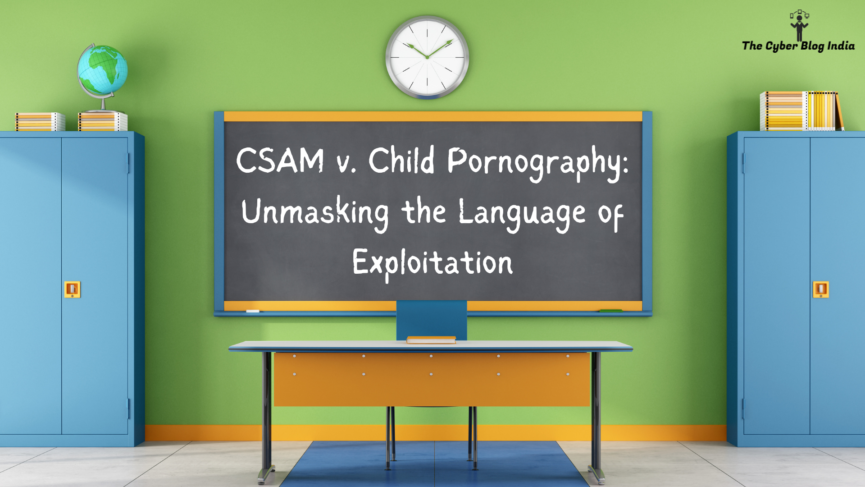CSAM v. Child Pornography: Unmasking the Language of Exploitation

Words are powerful. They can either unite us or divide us. But sometimes, the words we use can be more than just inaccurate. They can be downright harmful, especially when it comes to sensitive topics like sexually explicit content involving children. It is important that the language we use accurately reflects the gravity and illegality of these crimes. This is precisely why we need to pay close attention to the distinction between “child pornography” (CP) and “child sexual abuse material” (CSAM).
Legal Lingo: Defining CSAM and Child Pornography
In legal and media discourses, the term child pornography often surfaces, embedded deeply within statutory language and public discussions. However, the term pornography typically implies material created and consumed for sexual pleasure among consenting adults. In India, Section 2(1)(da) of the Protection of Children from Sexual Offences Act, 2012 (“POCSO”) defines the term child pornography as:
“any visual depiction of sexually explicit conduct involving a child which includes photographs, videos, digital or computer-generated images indistinguishable from an actual child, and images created, adapted, or modified but appear to depict a child.”
Even this definition, though comprehensive, skirts the inherent issue that such material is a byproduct of abuse and exploitation by predators and is not a participatory act by the child. Section 67B of the Information Technology Act, 2000 has a broader scope, but it continues to use the term child pornography.
On the other hand, child sexual abuse material explicitly identifies the material as a product of sexual abuse. It correctly highlights the criminality and victimisation of children involved. This term clarifies that the children depicted are not participants but victims, and their exploitation is a form of sexual assault. The term CSAM is thus more accurate and plays a crucial role in the legal and societal recognition of the severity of these crimes.
CSAM: Addressing the Shortcomings of CP
The importance of adopting the term child sexual abuse material is further underscored by authoritative sources and legal documents. According to a detailed explanation by the US Department of Justice, the use of the term CSAM is crucial in legal contexts as it directly emphasises the abuse suffered by minors. An NCMEC publication elaborates on how CSAM refers explicitly to materials that depict sexual abuse or exploitation of children. It also highlights how this term aids in more apparent legal interpretations and focused legislative measures.
The Global Recognition Saga ft. CSAM
In 2016, an international working group recognised child sexual abuse material as the preferred term. This working group consisted of various countries and international organisations working to combat the exploitation of children. Supporting this shift, India’s National Human Rights Commission (NHRC) recommended adopting the term to convey the exploitative nature of these materials. This recommendation aligns with global trends, where the language used in legal frameworks is evolving to represent the seriousness of these offences more accurately.
Moreover, educational efforts by advocacy groups like Stop It Now! further validate the shift in terminology. Their content on defining CSAM explains how moving away from terms like child pornography can significantly impact public understanding and attitude. RAINN, a US-based anti-sexual violence organisation, underlines the imperative to view these materials not as a form of pornography. Such material’s consideration as a form of pornography carries lesser negative connotations. It must be considered as clear evidence of criminal abuse.
The Language of Trauma: CSAM and CP’s Psychological Weight
The term child pornography carries a heavy stigma, implying a level of consent and participation that is not present in child sexual abuse cases. The term can inadvertently victim-blame and perpetuate harmful myths about abuse. On the other hand, child sexual abuse material accurately reflects the nature of the crime, highlighting the non-consensual and exploitative nature of the content. It acknowledges the trauma experienced by the victims and places the blame squarely on the abusers. This linguistic precision validates the experiences of victims, reduces stigma, and empowers individuals to speak out against their abusers. All of these lead to a stronger stance against child sexual abuse. Stakeholders, including legislators, media, and civil society, can better support the legal processes and societal changes necessary to address and prevent the exploitation of children.
Navigating the Transition: Considerations in Adopting the CSAM term
In the quest for a more empathetic and accurate portrayal of crimes involving minors, the shift from CP to CSAM has been a pivotal step. However, while advocating for this change, it is crucial to consider the challenges that come with it. Some may argue that the term child pornography is an insensitive term due to its normalisation of exploitation. At the same time, there is a risk that the term child sexual abuse material may lead to desensitisation. CSAM, being a more technical term, may not evoke the same emotional response or immediate understanding as CP. This risk highlights the importance of ensuring that the gravity of the issue is not lost in the transition.
Furthermore, there is the issue of familiarity. Will the public readily understand and accept the term CSAM? Or will it require extensive explanations and education?
Conclusion: The Verdict Lies Within
The world is a complex place. When it comes to discussing crimes against minors, language plays a crucial role. Have you ever considered the impact of the words we use to describe these heinous acts? Well, the shift to using the term CSAM over CP is a clear indication of the need for sensitivity and accuracy while discussing crimes against minors. However, this debate is not just about terminology but also how we perceive and address these crimes. Can we really fight exploitation without acknowledging its true nature? We must decide if we want to stick to the old, insensitive ways or embrace a more empathetic and nuanced language. After all, language shapes perception, and perception drives action.
